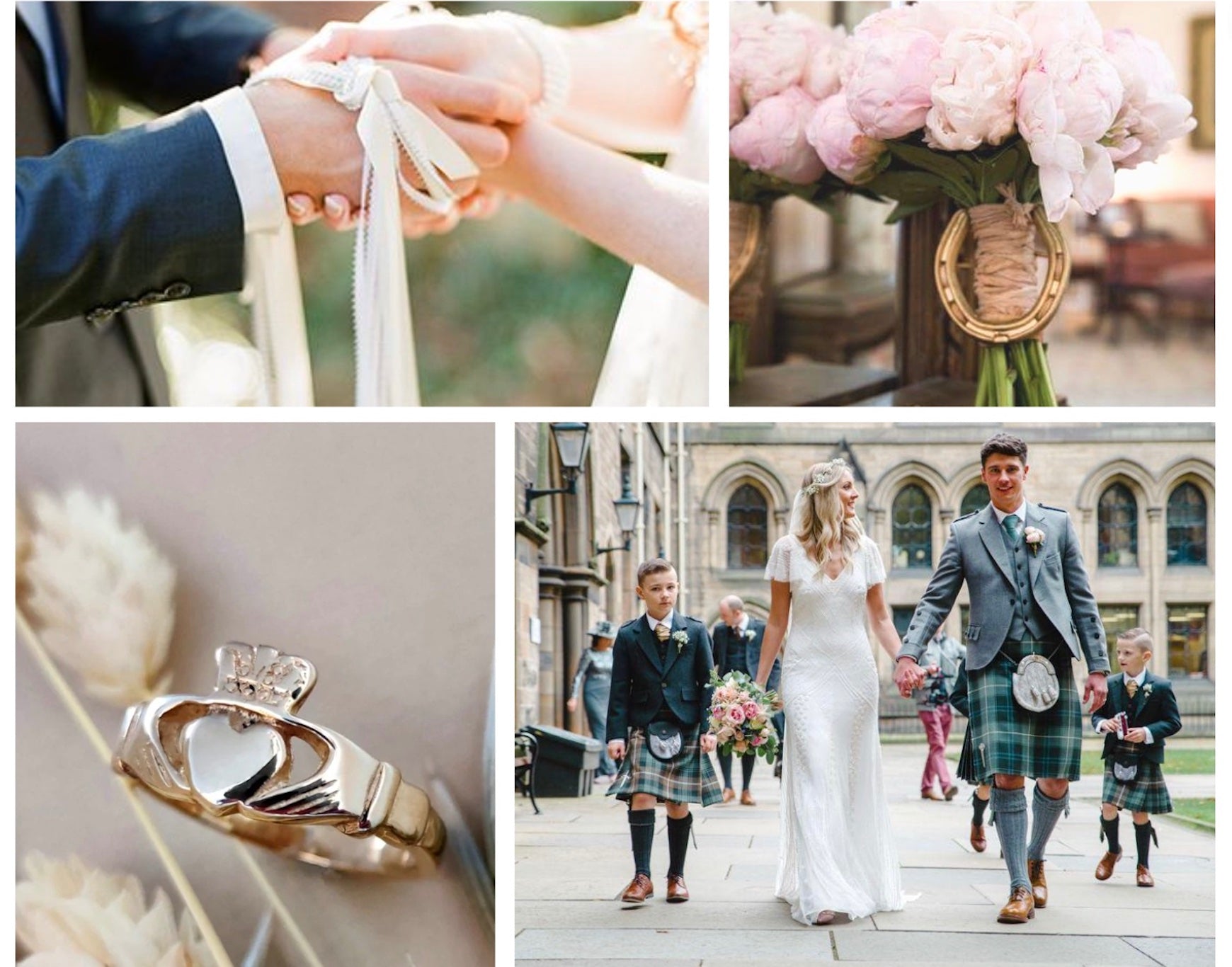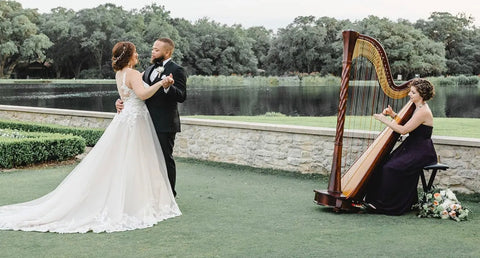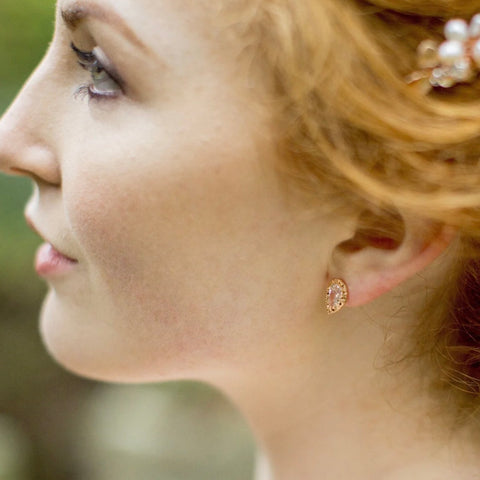The Irish Wedding Traditions That You Need to Know

As a country that has a long history, there are so many traditions and heritage in Ireland to embrace. Even in modern days, couples will incorporate Irish traditions into their wedding. But what do they mean and where did they come from? You’ll enjoy the wedding celebration more by understanding the sentiment and meaning behind these Irish traditions and Celtic symbols of love. Keep reading for everything you need to know about Irish wedding traditions!
Table of Contents
- The Wedding Dress with Irish Elements
- The Irish Kilt for The Groom
- Carrying a Horseshoe Walking Down the Aisle
- Sixpence in the Shoe
- Claddagh Rings Exchange
- Handfasting
- The Wedding Bells
- Altin’ The Gander
- Something Blue
- The Magic Hanky
- Irish Uilleann Pipes or Celtic Harps
- The Irish and Celtic Lucky Symbols
- Bridesmaids Gifts From The Bride
The Wedding Dress with Irish Elements

Some Irish brides will have their wedding dresses specially made with Irish lace. To add a touch of luck, they will get some Celtic symbols of luck embroidered on their wedding dresses in white. Symbols such as Celtic knots, shamrocks, and Irish crosses are widely used by some brides. Having said that, modern Irish brides who prefer designer bridal gowns can also embroider the symbols inside the gown and hide them away so they don’t affect the overall look of the gown.
The Irish Kilt for The Groom

In Celtic heritage, Kilts are worn by men in celebrations or special occasions. In Irish weddings, the Grooms will wear a full formal Irish kilt with either their own family tartans, or the tartans representing the counties and districts in Ireland. As there are only a few Irish families that have their own tartans registered, most of the people will wear kilts with the tartans of the counties or province that they are from. The grooms will most likely pair the kilts with a white shirt and a bow tie to add a touch of formality to the wedding.
Carrying a Horseshoe Walking Down the Aisle

The tradition of horseshoes goes way back to the Victorian Era. The horseshoe sought to fill the wedding day with omens of good luck and fortune. Associating the horseshoe to the crescent moon, it gives the horseshoe the symbolism of fertility as well. In Irish weddings, the brides will walk down the aisle carrying a readily-made horseshoe with the open side facing up, so the luck never runs out. The groom will fasten it securely to the matrimonial home after the wedding, meaning to bring the luck into the house and marriage.
Sixpence in The Shoe

A very old English wedding tradition is on the wedding day, the father of the bride will slip a silver sixpence into the bride’s heels before she walks down the aisle. The silver sixpence represents luck and prosperity and the tradition is meant to bring the prosperity of the marriage from the father to the bride and her future husband. It is also a way for the father to wish the bride and groom a happy, loving and everlasting marriage.
Claddagh Rings Exchange

A Claddagh Ring features two hands holding a love heart with a crown over the heart. The Irish Claddagh Ring traces back to the 16th Century in Galway and ever since then it has become very common to exchange the rings in Irish wedding ceremonies. When a couple is engaged, traditionally they may choose to wear the Claddagh Rings with the bottom of the heart facing away from the wrist. During wedding ceremonies in Ireland, newlyweds exchange the rings by putting on the rings with the bottom of the heart facing towards the wrists, also meaning to have the hearts of the rings facing the couple’s own hearts. This sends a silent message to the others so everyone can know whether a person is engaged or married.
Handfasting

Handfasting is a symbol of unity being practised in modern Irish wedding ceremonies. It is an ancient Celtic tradition, which dates back to 7000 B.C. Traditionally when a couple is brought together to be married, a piece of cord will be used to bind their hands together, symbolising two people joining lives. Handfasting is also where the modern expression “tying the knots” comes from.
In the mediaeval times, the ancient Celtic law would grant the handfasting ceremony the recognition of the start of a “trial” of marriage, similar to an engagement in modern times. The “trial period” will last exactly a year and one month and the couples can live together to see if they are compatible and ready to officially commit to a marriage with each other. Nowadays, handfasting is less official but a lot of Irish engaged couples will still embrace this tradition and do the handfasting in their wedding ceremonies while exchanging the vows.
The Wedding Bells

Ringing bells aloud is symbolic of warding off the evil spirits. Ringing bells in a wedding is also a traditional belief to drive the discord away from a marriage, which is why the church bells will ring after a wedding ceremony in a church wedding. During the Penal times in Ireland, wedding guests would give small bells to the newlyweds as a wedding gift traditionally.
In today’s time, you can still easily see small bells incorporated into different elements in an Irish wedding, such as the stationery, the invitations and decorations. In some Irish weddings, tiny bells will be given to the bridesmaids to ring while the newly married couple walks out from the church or down the aisle after the ceremony.
Altin’ The Gander

Altin’ the gander means “the goose is cooked”. The phrase originated from the tradition of cooking a goose in the Bride’s house the night before the wedding for the groom to eat. It refers to the meaning of “once the goose is cooked, there is no going back”. The tradition also symbolises the bride and the groom are officially soon to be and there’s no going back now. The phrase is still being widely used in Ireland, especially in Dublin.
Something Blue

Having something blue in weddings is a global practice because blue is the colour of fidelity and it is considered to be a lucky colour for the brides. But did you know that having something blue in Irish weddings is a tradition also because the colour used to be the national colour of Ireland until the 19th Century? For hundreds of years before then, the Irish National Flag was blue in the background with a gold Celtic harp. So it actually does have an extra layer of meaning to have something blue in an Irish wedding!
The Magic Hanky

Irish brides carry a white handkerchief that is usually made in linen throughout the entire wedding day. This is a sentimental Irish tradition that has been practised for cCenturies. The hanky will later be sewed or converted into a bonnet for the couple’s first born child to use in the baby’s Christening ceremony. The magic hanky would be passed on from mothers to daughters and from generation to generation, to be reused by each generation. A lot of brides nowadays will have some lucky symbols embroidered on the hanky such as shamrocks.
Irish Uilleann Pipes or Celtic Harps


Irish Uilleann Pipes are smaller in size and the sounds are known to be sweeter compared to the Scottish bagpipes. That’s why they are quite popular to be used in an Irish wedding. Traditionally the pipes will be played when the guests start to arrive as well as when the bride has arrived at the church. The pipers will also lead the newly married couple out the church after they said “I do”. Another popular choice of instrument to be featured in an Irish wedding is the Celtic Harp. Renowned for its gentle tone, a lot of Irish couples like to choose it as their wedding music to add a touch of romantic effect to the wedding.
The Irish and Celtic Lucky Symbols

Lucky symbols such as the famous Irish shamrocks and the aforementioned horseshoes, sixpence and wedding bells all can be incorporated into an Irish wedding to bring all the luck to the newlyweds and their marriage. The iconic Celtic Knot is also widely used in the Irish weddings, as the knot has no beginning and no end, it represents unity. Today, a lot of Irish couples will try to convert the traditional practices into small wedding elements. Don’t be shy to add small bells everywhere in your venue or decorations and print those beautiful shamrocks on the invitation cards!
Bridesmaids Gifts From The Bride

At the rehearsal dinner, brides traditionally give gifts to their bridesmaids. Typically, the bride would give toasts to her bridesmaids before presenting each of them with a gift. You can think about planning a bridal luncheon especially for the ladies as a change of pace. Jules Bridal offers a collection of gorgeous bridesmaids gifts, from sparkling jewellery to elegant headpieces, check out our Bridesmaids Gifts collection now for inspirations!
Frequently Asked Questions
How long do Irish weddings last?
Most Irish weddings last a whole day with the wedding ceremony being held in the morning, reception in the afternoon and formal meals and dancing in the evening as celebrations. However, some couples may host a rehearsal dinner a night before the wedding, serving nice meals and drinks to their guests. It all depends on your budget and the style of your wedding.
What is the traditional Irish wedding gift?
Bells. Traditionally, the ringing of bells is believed to be able to cast away evil spirits and keep the married couples away from disputes and bad luck. A lot of people may choose gifts that have prints of bells on them, in order to add a traditional touch.
Is there a traditional Irish wedding song?
While there is no one particular traditional Irish wedding song for the bride to walk down the aisle, some traditional Irish or Celtic folk songs are quite popular for couples to play in their wedding, such as “Only our rivers run free” and “Galway Bay”.
What is the traditional Irish wedding blessing?
Some traditional Irish wedding blessings are:
"May you have love that never ends,
lots of money, and lots of friends.
Health be yours, whatever you do,
and may God send many blessings to you!"
or
"Happy is the bride that rain falls on
May your mornings bring joy and your evenings bring peace.
May your troubles grow few as your blessings increase.
May the saddest day of your future
Be no worse than the happiest day of your past.
May your hands be forever clasped in friendship
And your hearts joined forever in love.
Your lives are very special,
God has touched you in many ways.
May his blessings rest upon you
And fill all your coming days.”
We swear by peace and love to stand,
Heart to heart and hand to hand.
Hark, O Spirit, and hear us now,
Confirming this our Sacred Vow."
Leave a comment
Comments will be approved before showing up.
